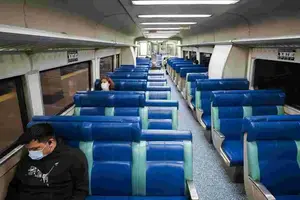
While subway ridership in New York fell to similar lows, it's seen a faster uptick and is now down roughly 60 percent. And buses, which primarily serve essential workers who must commute, have recorded 50 percent of its usual ridership for most of the pandemic. MTA leaders have warned that ridership may not rebound until 2023 — and even then may never hit 2019 levels again.
Depressed rail ridership creates a “paradox” for transit officials, who must contend with subsidizing a system that people may use less but still rely on for service, said Mohamed Mezghani, secretary General of the International Association of Public Transport.
“I would not say it will reach the levels we knew in the past, but we can't say that people will stop using it,” he said. “They will certainly use it less because working from home will stay — not full time, but part time.”
Transit agencies managed to stave off draconian service cuts after receiving billions in aid from federal stimulus packages. But new revenue streams may be necessary to help bolster rail in the long-term.
Globally the Covid pandemic is on track to be worse this year than in 2020 — and world health leaders are calling on wealthy nations to step up their game. Plus, more on tax hikes and sanctions on Belarus.
The conundrum could rejuvenate the debate about creating dedicated subsidy streams for commuter rail lines, some of which were already struggling to balance their books. That could mean things like value capture, where developers who build near transit systems have to contribute annual taxes toward their upkeep. Transit officials in cities like New York also see vast potential for congestion pricing — which charges drivers a European-style toll to drive into busy downtowns — to help fund their systems.
Other experts said the federal government may need to start taking a more proactive role in contributing to the operating budgets of public transit agencies, instead of just funding big construction projects. The stimulus packages encouraged that conversation by contributing to transit agencies’ bottom line when fare revenue had all but evaporated during the pandemic.
“The Covid funding that was offered in this first [federal package] really shifted the discussion in ways advocates have been pushing for,” said Stephanie Gidigbi Jenkins, the previous director of strategic initiatives at the federal Department of Transportation under the Obama administration. “It makes no sense to build out a system and not pay for the people who will actually make sure you get to where you need to.”
Several see greater potential for that shift under President Joe Biden, who was a frequent user of Amtrak’s regional rail in the Northeast before taking office. Biden’s massive infrastructure package, which is now being negotiated with Congress, calls for $85 billion to support public transit agencies and $80 billion for Amtrak. State legislators in New York are pushing Congress to permanently cover some of the MTA’s operating costs.
The pandemic has also forced transit agencies to rethink the services they provide to better accommodate 21st-century riding patterns. An expansion of rush hour service to go beyond the early morning and evening commute may be necessary to capture new flexibilities in work schedules, said Gidigbi Jenkins, who also sits on the board of the Washington Metropolitan Area Transit Authority. WMATA board members are also wrestling with changing fare structures as fewer people buy monthly passes.
“It’s going to force a different conversation on the service levels,” Gidigbi Jenkins said. “Covid brought to light the things we turned a blind eye to in several ways. We've not rightsized the service hours with the real use of the system.”
Those conversations are also occurring in New York, where 35 percent of the Long Island Rail Road’s ridership used to occur during the morning and evening rush. Rush hour now starts much earlier because of essential workers’ schedules, with 7 a.m. and 3 p.m. becoming the new peak times.
“That [shift] is helping us spread out ridership across the 24-hour day, and maybe that changes our need for rolling stock and the size of trains and how we support the ridership of the future,” said Phil Eng, president and CEO of the LIRR.
Eng said the agency is also looking at adding more local service to better accommodate “reverse peak.”
“As businesses rethink where their main hubs will be and consider staying in Manhattan or not, we will be looking to serve that reverse commute and to serve anyone who needs to travel inter-island,” he said.
Some transit agencies are also putting greater stock in how people use the system outside of work.
Before the pandemic, New York was contending with a steady growth in commuter ridership. But in recent weeks, weekend ridership has surpassed weekday ridership — highlighting an eagerness to use commuter rail for baseball games or dinner, Eng said.
“The days of the Long Island Rail Road rider being just five days a week — get on the train in the morning to go to Manhattan and at the end of day go home — it's shifted,” he said
In Austin, Texas, transit officials are looking to capitalize on that trend.